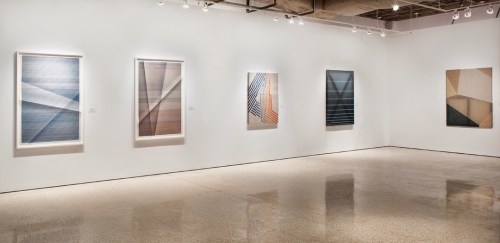
Installation view of works by John Houck and Rebecca Ward.
Reviews: Linear Abstraction for the 21st Century
By Caroline Stover
March 4, 2014
This year marks the 100th anniversary of a turning point in the history of visual art, when Russian artist Kazimir Malevich created his momentous 1915 paintings of black squares on white backgrounds. It was the beginning of an intense shake-up of artistic expression in the 20th century.
With that historical perspective in mind, the Savannah College of Art and Design’s Gutstein Gallery seeks to spark a dialogue about the progression of creative ideas in this century with the exhibition “Linear Abstraction,” an impressive gathering of 11 international artists who are exploring new levels of meaning and intention within “the legacy and historical lineage of Abstraction.” Thoughtfully organized by SCAD curators Alexandra Sachs and Aaron Levi Garvey, the exhibition’s diverse works cover the bases from painting to sculpture to video to photography to “process art,” all within the thematic framework of linear or geometric forms.
Texas-born, Brooklyn-based Rebecca Ward is one of several artists in the show whose ideas take form via a unique manipulation of her materials. Ward uses fabric, hand-stitching, and weaving to create visually nuanced pieces with tranquil colors and shapes. She also deconstructs the canvas to reveal the stretcher bars behind the painting, introducing an unexpected graphic element and inviting the viewer to experience the painting as multidimensional. In Memory Ache the horizontal threads in the lower half of the canvas have been meticulously removed by the artist so that the wooden stretcher appears, floating behind a delicate curtain of vertical strings.
Physical interaction is a theme for painters Rafael Vega and Russell Tyler as well. Vega, a Puerto Rican native who lives and works in Brooklyn, cuts narrow slashes in the wood panel and Masonite surfaces of his work to enhance his softly vibrant, painted geometric shapes. Tyler’s square-within-square paintings radiate with intense colors. Adding to the impact, the artist covers his canvases with deep swirling impasto, ensuring that his energetic engagement with the paint is part of the visual experience.
In his process-based work, John Houck writes computer code that produces a colorful gridlike design when printed, then he adds intersecting planes of shadow in a bit of sleight of hand—some shadows are created by actual creases in the paper, others by creases that Houck makes and then photographs. The result is an image that contains both an actual visual reality and a reality created by the artist’s process.
While Houck, Vega, and Ward incorporate architectural elements into their work, Bangladeshi-born Rana Begum is the exhibition’s sole sculptor. She lives in London, where urban architecture is one of many inspirations for her constructions. Her small folded metal sculptures are placed on tables in the gallery, affording viewers 360-degree access. Begum’s bent and brightly painted shapes appear flat from one angle and resemble fractals ready to take flight from other angles. The artist‘s large wall-mounted installation No. 529 is displayed in the front window of the gallery but is not visible from inside; it shouldn’t be missed for its captivating light-filled colors and shapes.
The most interesting artists of any generation are those who find ways to challenge the established norms, principles, and foundations of their art. German artist Marco Breuer is known for his unconventional work in photography where he dispenses with the camera and focuses on manipulation of photographic paper to produce his images. Breuer’s three chromogenic paper works in “Linear Abstraction” are partially or fully exposed to light, then embossed, burned, scraped, and folded. None of the pieces in the exhibition appear to bear the marks of his teeth, a tool that he has been known to use, but the synergy of the artist and his materials is nevertheless deeply apparent in these works.
Walead Beshty is also known for pushing the traditional boundaries of the photographic process. Black Curl is from his photogram series, a project that originated when Beshty accidentally exposed a roll of film in an airport X-ray machine. His photograms are experiments with light and technology that produce intriguing results, each image one of a kind, its uniqueness inherent in the unpredictability of the process.
The video installations by Phillip Stearns are the final diverse elements in the exhibition. His Coplanar Nations: Israel & Palestine is the only overtly political piece in the show. The video is a hypnotic overlap of moving and flying geometric shapes laced with static, in the colors of those two country’s flags: blue, white, black, green, and red. Stearns’s work brings the exhibition full-circle, resonating with themes that are explored by the artists throughout the gallery: technology, deconstruction, engagement, tools, materials, reality, virtual reality.
If art functions as a way to get people talking, then “Linear Abstraction” has provided a strong springboard for discussion about what this century’s artists may attain.
The show is also representative of an art world milestone that still has a ways to go, especially where abstract art is concerned: the inclusion of more female artists and their impact. Of the 11 artists in the Gutstein show, three are women, a stark imbalance, but taken from a historical perspective, it’s progress. And progress is all anyone can ask for as we journey through the second decade of art in the 21st century.
Caroline Stover is a resident of Atlanta and works in publishing and artist representation.